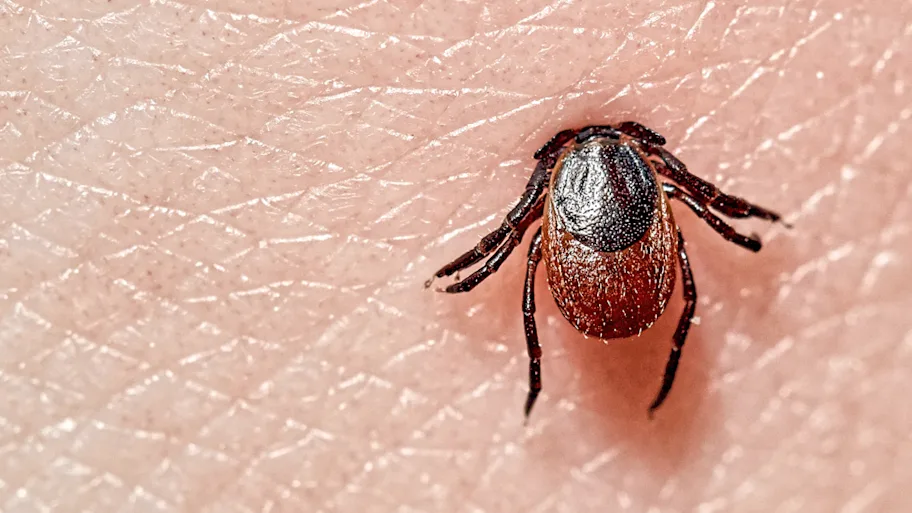
- Science News
- Health
- Severe and lingering symptoms occur in some after treatment for Lyme disease
Severe and lingering symptoms occur in some after treatment for Lyme disease

Image: Shutterstock
In a study of 61 people treated for the bacteria that causes Lyme disease, Johns Hopkins researchers conclude that fatigue, pain, insomnia and depression do indeed persist over long periods of time for some people, despite largely normal physical exams and clinical laboratory testing.
-By Johns Hopkins University
“Post-treatment Lyme disease syndrome (PTLDS) is a real disorder that causes severe symptoms in the absence of clinically detectable infection,” says John N. Aucott, M.D., associate professor of medicine at the Johns Hopkins University School of Medicine and director of the Johns Hopkins Lyme Disease Clinical Research Center.
The findings, published in the December issue of Frontiers in Medicine, could spur further investigation into the cause of persistent symptoms, a source of medical controversy. As Lyme disease rates have steadily climbed in the United States since it was first recognized in the mid-1970s, so have reports of a collection of symptoms that patients commonly refer to as chronic Lyme disease. Experts in the field have questioned the validity of this term because of the lack of direct evidence in this group of patients of ongoing infection with Borrelia burgdorferi, the bacterium that causes Lyme disease.
Efforts to better understand patients with these symptoms have largely failed, says Aucott, because patients grouped under the umbrella term “chronic Lyme disease” could belong to one of various subgroups.
“People have been comparing apples to oranges by grouping all of those with chronic Lyme disease together,” he says. “Our study was designed to compare apples to apples.”
To do that, Aucott and his colleagues first agreed to study individuals with PTLDS, a disorder defined by the Infectious Diseases Society of America as the development of significant fatigue, widespread musculoskeletal pain and/or cognitive difficulties that arise within six months after completion of antibiotic therapy for physician-documented Lyme disease and that last for at least six months. They meticulously gathered prior medical records for evidence of Lyme disease and excluded patients with conditions that may mimic those of PTLDS.
Aucott cautions that because so little is known about the origins of PTLDS, its underlying cause has remained unclear, and a range of hypotheses exist. This study, and the term “PTLDS,” do not define the cause of the condition, but do provide a starting place for future studies.
The researchers recruited 61 patients who were either self- or physician-referred to the Lyme Disease Clinical Research Center at Johns Hopkins and who met the study criteria. Roughly half were women and half were men, ranging in age between 18 and 82. Also recruited were 26 healthy controls, also split nearly evenly between the sexes and about the same ages as the other group, with no clinical history of Lyme disease symptoms and no antibodies to Borrelia burgdorferi that would indicate past or current infection.
For each of these individuals, Aucott and his team ran a comprehensive battery of clinical and laboratory tests. A trained interviewer collected a detailed medical history, and participants received a physical exam that assessed vital signs and examined various organs and joints. They also received an extensive neurological assessment. Laboratory tests checked for general markers of health in their blood as well as antibody markers of past exposure to Lyme disease. Study participants also completed standardized questionnaires that measure the severity of fatigue, pain, sleep disturbance and depression, as well as quality of life.
Aucott says that between the two groups, few clinically significant differences existed in results of the physical exams and clinical laboratory tests, except for an abnormal inability to sense vibrations in some PTLDS patients. The diminished vibratory sensation is a marker for neurologic involvement that has been seen in other studies of Lyme disease
“By and large, all the test and exam results from both the PTLDS patients and the healthy controls were not statistically significantly different by group, including their blood tests and physical exams.” Aucott says. “We found no truly objective markers of PTLDS on any of these clinically available tests.”
However, he says, there were significant differences in the results from the questionnaires. About 50 percent of the PTLDS patients reported severe fatigue, about 28 percent reported severe pain, about 23 percent reported severe cognitive complaints and about 31 percent reported severe sleep difficulty. None of the healthy controls reported any symptoms in the “severe” range. In total, the researchers found 19 symptoms that are not part of the standard PTLDS criteria to be significantly more severe among the study participants with PTLDS than among controls. These included such symptoms as severe sleep difficulty (reported by 32 percent of PTLDS patients), severe neck pain (reported by 8percent of PTLDS patients), severe numbness/tingling in hands or feet (reported by 10 percent of PTLDS patients), severe irritability (reported by 8 percent of PTLDS patients), severe low back pain (reported by 3 percent of PTLDS patients) and severe headache (reported by 17 percent of PTLDS patients).
These symptoms, Aucott says, appear to reflect the significantly higher scores in a measure of depression and significantly lower scores on the SF-36, a widely used 36-item questionnaire that measures health-related quality of life.
“Even though their exams and lab tests didn’t show much in the way of a common or clear biological marker or markers of PTLDS, it’s clear these patients don’t feel well,” says study co-author Kathleen Bechtold, Ph.D., associate professor of physical medicine and rehabilitation at the Johns Hopkins University School of Medicine. “These symptoms are more severe than what the average non-PTLDS patient is experiencing even on a bad day.”
The findings show distinct differences between PTLDS and the normal aches and pains of daily life, Bechtold adds. Even with no objective laboratory or exam markers, she says, the results of this study suggest that PTLDS can be diagnosed through careful and thorough examination of symptoms.
More accurate identification of the subset of patients with PTLDS would go a long way to improving diagnosis and care of this specific subgroup and eventually to allowing future studies of specific therapies. To this end, Aucott and his group are currently analyzing cognitive testing results and blood samples taken from patients who participated in this study to search for research biomarkers that were not examined in the initial study.
An estimated 300,000 people in the U.S. are diagnosed each year with Lyme disease according to the Centers for Disease Control and Prevention. Of those ideally diagnosed and treated, studies have reported a wide range (5 to 30 percent) of the proportion that goes on to experience PTLDS. In this study, risk factors such as delayed diagnosis and exposure to inappropriate antibiotics and steroids prior to appropriate treatment occurred in over half the PTLDS patients.
Original research article: The Clinical, Symptom, and Quality-of-Life Characterization of a Well-Defined Group of Patients with Posttreatment Lyme Disease Syndrome
Corresponding author: Dr. John N. Aucott
REPUBLISHING GUIDELINES: Open access and sharing research is part of Frontier’s mission. Unless otherwise noted, you can republish articles posted in the Frontiers news blog — as long as you include a link back to the original research. Selling the articles is not allowed.






